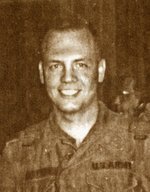
|

|
|
|
|
Samuel was born at home in San Antonio to Samuel W. Hopkins and Clara Clark Hopkins. He had one sister, two years his junior. His father was a postal supervisor, who did accounting and income tax work as a sideline. Samuel graduated from Thomas Edison High School in 1956 and entered Trinity University in San Antonio, where he majored in mathematics and served in ROTC for four years. When he graduated in 1960 he was commissioned as an artillery officer. He completed seminary at Southern Methodist University, and served two pastorates. At a Methodist church in Terrell, Texas, he met Patsy Ruth Loden. They married on March 12, 1964. (They would have three children and six grandchildren.) Later, they moved to Stockdale, Texas, where he pastored a Methodist church. Samuel entered active duty as a chaplain on January 10, 1966. After Chaplain's School Orientation in Fort Hamilton in Brooklyn, New York, he was sent to Fort Bliss in El Paso, Texas, where he arrived in March of 1966. He was designated as chaplain of 4th Battalion, 60th Artillery, comprised of 800 men who "trained together, knowing we were going to ship out together to Vietnam," he says. "We served our tour together and we came home together." The troop ship left on February 12, 1967, with 3,100 other personnel, and arrived in Vietnam at Qui Nhon on March 11, 1967 during what was, he says, "the height of the build-up." There the battalion was tasked with fire missions for personnel support. "We were in really high demand for infantry support on search and sweep operations and for perimeter defense and convoy escort," he says. Their artillery supported 1st Air Cavalry Division and 4th Infantry Division. They also provided support in operations with the 173rd Infantry Division and the 101st Airborne Division. From battalion headquarters at Qui Nhon, he drove to bases throughout the 2nd Corps area ministering to 800 men in the battalion. He traveled with Robert Bishop, a chaplain's assistant, who served as his driver, clerk-typist, and bodyguard. They often made fifteen stops in two days. While he performed some type of religious service each day, he held a formal service on Sunday at the base camp. He also was involved in Civic Action Projects, in helping villagers by providing commodities such as cooking oil and soap, as well as additional security. He took time off for rest and rehabilitation (R&R), meeting his wife in Hawaii. He recalls the Tet Offensive in January of 1968 as "really over almost as soon as it started. He visited units where "they had just mowed people down," in defending themselves against mass attacks. "It was a terrible loss for the other side but a great political victory for them," he remarks. Samuel left Vietnam on February 7, 1968. After flying home from Cam Ranh Bay he was assigned to Fort Hood, Texas, where he served in 2nd Armored Division. He left active duty on May 30, 1969 as a captain, then earned a PhD at The University of Texas at Austin. He remained in service, however, first with Army Reserve and then with the National Guard, finally attaining the rank of colonel. Samuel worked as a psychologist in state hospitals and eventually in state prison mental health programs, before retiring in 1999. Samuel wrote a book about his service, A Chaplain Remembers Vietnam. He also authored How to Win in Tennis Leagues. In 2004, he returned to Vietnam with a group of veterans, escorting Gold Star Mothers to places where their sons served. "It was just as pretty as I remembered it," he recalls of seeing the country again. "You know, we didn't lose the war; somebody forfeited it," he says. |


